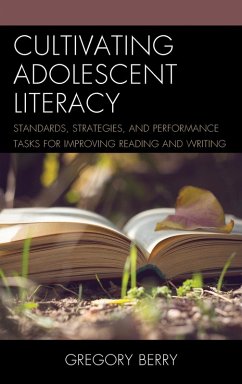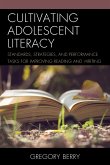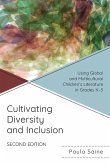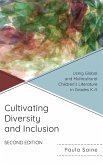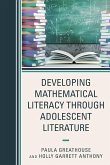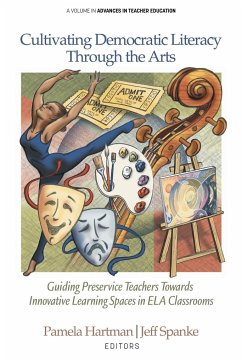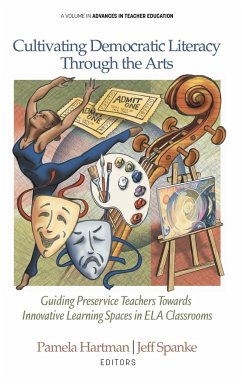Gregory Berry
Cultivating Adolescent Literacy
Standards, Strategies, and Performance Tasks for Improving Reading and Writing
Gregory Berry
Cultivating Adolescent Literacy
Standards, Strategies, and Performance Tasks for Improving Reading and Writing
- Gebundenes Buch
- Merkliste
- Auf die Merkliste
- Bewerten Bewerten
- Teilen
- Produkt teilen
- Produkterinnerung
- Produkterinnerung
This book offers middle and high school teachers useful suggestions and strategies for cultivating literacy in their classrooms.
Andere Kunden interessierten sich auch für
![Cultivating Adolescent Literacy Cultivating Adolescent Literacy]() Gregory BerryCultivating Adolescent Literacy48,99 €
Gregory BerryCultivating Adolescent Literacy48,99 €![Cultivating Diversity and Inclusion Cultivating Diversity and Inclusion]() Paula SaineCultivating Diversity and Inclusion56,99 €
Paula SaineCultivating Diversity and Inclusion56,99 €![Cultivating Diversity and Inclusion Cultivating Diversity and Inclusion]() Paula SaineCultivating Diversity and Inclusion135,99 €
Paula SaineCultivating Diversity and Inclusion135,99 €![Developing Mathematical Literacy through Adolescent Literature Developing Mathematical Literacy through Adolescent Literature]() Developing Mathematical Literacy through Adolescent Literature46,99 €
Developing Mathematical Literacy through Adolescent Literature46,99 €![Cultivating Democratic Literacy Through the Arts Cultivating Democratic Literacy Through the Arts]() Cultivating Democratic Literacy Through the Arts62,99 €
Cultivating Democratic Literacy Through the Arts62,99 €![Cultivating Democratic Literacy Through the Arts Cultivating Democratic Literacy Through the Arts]() Cultivating Democratic Literacy Through the Arts106,99 €
Cultivating Democratic Literacy Through the Arts106,99 €![Fostering Mental Health Literacy through Adolescent Literature Fostering Mental Health Literacy through Adolescent Literature]() Fostering Mental Health Literacy through Adolescent Literature47,99 €
Fostering Mental Health Literacy through Adolescent Literature47,99 €-
-
-
This book offers middle and high school teachers useful suggestions and strategies for cultivating literacy in their classrooms.
Hinweis: Dieser Artikel kann nur an eine deutsche Lieferadresse ausgeliefert werden.
Hinweis: Dieser Artikel kann nur an eine deutsche Lieferadresse ausgeliefert werden.
Produktdetails
- Produktdetails
- Verlag: Rowman & Littlefield Publishers
- Seitenzahl: 174
- Erscheinungstermin: 4. Oktober 2017
- Englisch
- Abmessung: 235mm x 157mm x 14mm
- Gewicht: 412g
- ISBN-13: 9781475838107
- ISBN-10: 1475838107
- Artikelnr.: 48696007
- Herstellerkennzeichnung
- Libri GmbH
- Europaallee 1
- 36244 Bad Hersfeld
- gpsr@libri.de
- Verlag: Rowman & Littlefield Publishers
- Seitenzahl: 174
- Erscheinungstermin: 4. Oktober 2017
- Englisch
- Abmessung: 235mm x 157mm x 14mm
- Gewicht: 412g
- ISBN-13: 9781475838107
- ISBN-10: 1475838107
- Artikelnr.: 48696007
- Herstellerkennzeichnung
- Libri GmbH
- Europaallee 1
- 36244 Bad Hersfeld
- gpsr@libri.de
Gregory Berry teaches English at South Salem High School, where he has also served as teacher leader, instructional coach, and department coordinator, and is an adjunct English instructor at Chemeketa Community College. He received his BA in English, BS in Education, and MS is education from Eastern Oregon University and his doctorate in educational leadership, curriculum, and instruction from Portland State University in 2009. He is the author of Literacy for Learning: A Handbook of Content Area Strategies for Middle and High School Teachers, published by Rowman & Littlefield in 2014.
Preface Acknowledgements Introduction Chapter One: English Language Arts,
Educational Reform, and the Common Core State Standards Movement A. Cycles
of Change B.The Common Core State Standards: Promise and Controversy
C.Holding on To Literature in the English Curriculum Chapter Two:
Cultivating Literacy Learning through Close Reading A. The Importance of
Integrating Reading and Writing B.Close Reading Strategies for Literary and
Informational Text 1. Close Reading: What it Is and Why It's Important
2.Close Reading Controversy C.What is Complex Text D.Suggested Close
Reading Strategies 1.Strategy One: Four Basic Questions 2.Strategy Two:
Think-Aloud 3.Strategy Three: Vocabulary: Structural Analysis and Context
Clues 4.Strategy Four: Reading Like a Writer 5.Strategy Five: Text Marking
6.Strategy Six: Charting the Text 7.Strategy Seven: Interactive Shared
Reading 8.Strategy Eight: Monitoring Comprehension 9.Strategy Nine:
Multiple Readings 10.Strategy Ten: Using Evidence from Text 11.Strategy
Eleven: Student-Determined Text-Dependent Questions 12.Strategy Twelve:
Teaching Text Structure 13.Strategy Thirteen: Color Coding of Text
14.Strategy Fourteen: Commentary 15.Strategy Fifteen: Analyzing a Source
16.Strategy Sixteen: Paraphrasing 17.Strategy Seventeen: KNOWS 18.Strategy
Eighteen: Apps for Promoting Reading Skill 19.Strategy Nineteen: The One
Pager Chapter Three: Textual Evidence and Elaboration A.Textual Evidence:
What it is and Why it's Important B.Simple Ways to Teach Textual Evidence
C.Sample Strategies 1. Color Coding Strategy 2.Poetry Explication:
Supporting Your Reading by Citing Textual Evidence 3.Using Transitions 4.A
Time to Dig Deeper: Answering Text-Based Question Chapter Four: Performance
Tasks for Specific Literary Texts A. What are Performance Tasks?
B.Performance Tasks for Specific Texts 1. Huckleberry Finn and 19th Century
Literature Performance Task 2. Cyrano De Bergerac Performance Task 3.The
Great Gatsby Performance Task 4.Our Town Performance Task 5.Of Mice and Men
Performance Task 6.The Crucible Performance Task 7.Ricochet River
Performance Task 8.The Bean Trees 9.House on Mango Street Performance Task
10.Poetry Performance Tasks i.Part One: Literary Analysis of Theme ii.Part
Two: Layered Curriculum 11.Poverty Performance Task Afterword: Letting Our
Garden Grow
Educational Reform, and the Common Core State Standards Movement A. Cycles
of Change B.The Common Core State Standards: Promise and Controversy
C.Holding on To Literature in the English Curriculum Chapter Two:
Cultivating Literacy Learning through Close Reading A. The Importance of
Integrating Reading and Writing B.Close Reading Strategies for Literary and
Informational Text 1. Close Reading: What it Is and Why It's Important
2.Close Reading Controversy C.What is Complex Text D.Suggested Close
Reading Strategies 1.Strategy One: Four Basic Questions 2.Strategy Two:
Think-Aloud 3.Strategy Three: Vocabulary: Structural Analysis and Context
Clues 4.Strategy Four: Reading Like a Writer 5.Strategy Five: Text Marking
6.Strategy Six: Charting the Text 7.Strategy Seven: Interactive Shared
Reading 8.Strategy Eight: Monitoring Comprehension 9.Strategy Nine:
Multiple Readings 10.Strategy Ten: Using Evidence from Text 11.Strategy
Eleven: Student-Determined Text-Dependent Questions 12.Strategy Twelve:
Teaching Text Structure 13.Strategy Thirteen: Color Coding of Text
14.Strategy Fourteen: Commentary 15.Strategy Fifteen: Analyzing a Source
16.Strategy Sixteen: Paraphrasing 17.Strategy Seventeen: KNOWS 18.Strategy
Eighteen: Apps for Promoting Reading Skill 19.Strategy Nineteen: The One
Pager Chapter Three: Textual Evidence and Elaboration A.Textual Evidence:
What it is and Why it's Important B.Simple Ways to Teach Textual Evidence
C.Sample Strategies 1. Color Coding Strategy 2.Poetry Explication:
Supporting Your Reading by Citing Textual Evidence 3.Using Transitions 4.A
Time to Dig Deeper: Answering Text-Based Question Chapter Four: Performance
Tasks for Specific Literary Texts A. What are Performance Tasks?
B.Performance Tasks for Specific Texts 1. Huckleberry Finn and 19th Century
Literature Performance Task 2. Cyrano De Bergerac Performance Task 3.The
Great Gatsby Performance Task 4.Our Town Performance Task 5.Of Mice and Men
Performance Task 6.The Crucible Performance Task 7.Ricochet River
Performance Task 8.The Bean Trees 9.House on Mango Street Performance Task
10.Poetry Performance Tasks i.Part One: Literary Analysis of Theme ii.Part
Two: Layered Curriculum 11.Poverty Performance Task Afterword: Letting Our
Garden Grow
Preface Acknowledgements Introduction Chapter One: English Language Arts,
Educational Reform, and the Common Core State Standards Movement A. Cycles
of Change B.The Common Core State Standards: Promise and Controversy
C.Holding on To Literature in the English Curriculum Chapter Two:
Cultivating Literacy Learning through Close Reading A. The Importance of
Integrating Reading and Writing B.Close Reading Strategies for Literary and
Informational Text 1. Close Reading: What it Is and Why It's Important
2.Close Reading Controversy C.What is Complex Text D.Suggested Close
Reading Strategies 1.Strategy One: Four Basic Questions 2.Strategy Two:
Think-Aloud 3.Strategy Three: Vocabulary: Structural Analysis and Context
Clues 4.Strategy Four: Reading Like a Writer 5.Strategy Five: Text Marking
6.Strategy Six: Charting the Text 7.Strategy Seven: Interactive Shared
Reading 8.Strategy Eight: Monitoring Comprehension 9.Strategy Nine:
Multiple Readings 10.Strategy Ten: Using Evidence from Text 11.Strategy
Eleven: Student-Determined Text-Dependent Questions 12.Strategy Twelve:
Teaching Text Structure 13.Strategy Thirteen: Color Coding of Text
14.Strategy Fourteen: Commentary 15.Strategy Fifteen: Analyzing a Source
16.Strategy Sixteen: Paraphrasing 17.Strategy Seventeen: KNOWS 18.Strategy
Eighteen: Apps for Promoting Reading Skill 19.Strategy Nineteen: The One
Pager Chapter Three: Textual Evidence and Elaboration A.Textual Evidence:
What it is and Why it's Important B.Simple Ways to Teach Textual Evidence
C.Sample Strategies 1. Color Coding Strategy 2.Poetry Explication:
Supporting Your Reading by Citing Textual Evidence 3.Using Transitions 4.A
Time to Dig Deeper: Answering Text-Based Question Chapter Four: Performance
Tasks for Specific Literary Texts A. What are Performance Tasks?
B.Performance Tasks for Specific Texts 1. Huckleberry Finn and 19th Century
Literature Performance Task 2. Cyrano De Bergerac Performance Task 3.The
Great Gatsby Performance Task 4.Our Town Performance Task 5.Of Mice and Men
Performance Task 6.The Crucible Performance Task 7.Ricochet River
Performance Task 8.The Bean Trees 9.House on Mango Street Performance Task
10.Poetry Performance Tasks i.Part One: Literary Analysis of Theme ii.Part
Two: Layered Curriculum 11.Poverty Performance Task Afterword: Letting Our
Garden Grow
Educational Reform, and the Common Core State Standards Movement A. Cycles
of Change B.The Common Core State Standards: Promise and Controversy
C.Holding on To Literature in the English Curriculum Chapter Two:
Cultivating Literacy Learning through Close Reading A. The Importance of
Integrating Reading and Writing B.Close Reading Strategies for Literary and
Informational Text 1. Close Reading: What it Is and Why It's Important
2.Close Reading Controversy C.What is Complex Text D.Suggested Close
Reading Strategies 1.Strategy One: Four Basic Questions 2.Strategy Two:
Think-Aloud 3.Strategy Three: Vocabulary: Structural Analysis and Context
Clues 4.Strategy Four: Reading Like a Writer 5.Strategy Five: Text Marking
6.Strategy Six: Charting the Text 7.Strategy Seven: Interactive Shared
Reading 8.Strategy Eight: Monitoring Comprehension 9.Strategy Nine:
Multiple Readings 10.Strategy Ten: Using Evidence from Text 11.Strategy
Eleven: Student-Determined Text-Dependent Questions 12.Strategy Twelve:
Teaching Text Structure 13.Strategy Thirteen: Color Coding of Text
14.Strategy Fourteen: Commentary 15.Strategy Fifteen: Analyzing a Source
16.Strategy Sixteen: Paraphrasing 17.Strategy Seventeen: KNOWS 18.Strategy
Eighteen: Apps for Promoting Reading Skill 19.Strategy Nineteen: The One
Pager Chapter Three: Textual Evidence and Elaboration A.Textual Evidence:
What it is and Why it's Important B.Simple Ways to Teach Textual Evidence
C.Sample Strategies 1. Color Coding Strategy 2.Poetry Explication:
Supporting Your Reading by Citing Textual Evidence 3.Using Transitions 4.A
Time to Dig Deeper: Answering Text-Based Question Chapter Four: Performance
Tasks for Specific Literary Texts A. What are Performance Tasks?
B.Performance Tasks for Specific Texts 1. Huckleberry Finn and 19th Century
Literature Performance Task 2. Cyrano De Bergerac Performance Task 3.The
Great Gatsby Performance Task 4.Our Town Performance Task 5.Of Mice and Men
Performance Task 6.The Crucible Performance Task 7.Ricochet River
Performance Task 8.The Bean Trees 9.House on Mango Street Performance Task
10.Poetry Performance Tasks i.Part One: Literary Analysis of Theme ii.Part
Two: Layered Curriculum 11.Poverty Performance Task Afterword: Letting Our
Garden Grow

